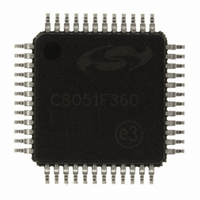C8051F360-GQ Silicon Laboratories Inc, C8051F360-GQ Datasheet - Page 176

C8051F360-GQ
Manufacturer Part Number
C8051F360-GQ
Description
IC 8051 MCU 32K FLASH 48TQFP
Manufacturer
Silicon Laboratories Inc
Series
C8051F36xr
Specifications of C8051F360-GQ
Program Memory Type
FLASH
Program Memory Size
32KB (32K x 8)
Package / Case
48-TQFP, 48-VQFP
Core Processor
8051
Core Size
8-Bit
Speed
100MHz
Connectivity
EBI/EMI, SMBus (2-Wire/I²C), SPI, UART/USART
Peripherals
POR, PWM, Temp Sensor, WDT
Number Of I /o
39
Ram Size
1K x 8
Voltage - Supply (vcc/vdd)
3 V ~ 3.6 V
Data Converters
A/D 17x10b; D/A 1x10b
Oscillator Type
Internal
Operating Temperature
-40°C ~ 85°C
Processor Series
C8051F3x
Core
8051
Data Bus Width
8 bit
Data Ram Size
1 KB
Interface Type
I2C/SMBus/SPI/UART
Maximum Clock Frequency
100 MHz
Number Of Programmable I/os
39
Number Of Timers
4
Operating Supply Voltage
3 V to 3.6 V
Maximum Operating Temperature
+ 85 C
Mounting Style
SMD/SMT
3rd Party Development Tools
KSK-SL-TOOLSTICK, PK51, CA51, A51, ULINK2
Development Tools By Supplier
C8051F360DK
Minimum Operating Temperature
- 40 C
On-chip Adc
21-ch x 10-bit
On-chip Dac
1-ch x 10-bit
Package
48TQFP
Device Core
8051
Family Name
C8051F36x
Maximum Speed
100 MHz
Lead Free Status / RoHS Status
Lead free / RoHS Compliant
For Use With
336-1483 - ADAPTER PROGRAM TOOLSTICK F360770-1006 - ISP 4PORT FOR SILABS C8051F MCU336-1412 - BOARD TARGET/PROTO W/C8051F360336-1411 - DAUGHTER CARD TOOLSTCK C8051F362336-1410 - KIT DEV FOR C8051F360 FAMILY
Eeprom Size
-
Lead Free Status / Rohs Status
Lead free / RoHS Compliant
Other names
336-1407
Available stocks
Company
Part Number
Manufacturer
Quantity
Price
Company:
Part Number:
C8051F360-GQ
Manufacturer:
Silicon Laboratories Inc
Quantity:
10 000
Part Number:
C8051F360-GQ
Manufacturer:
SILICON LABS/èٹ¯ç§‘
Quantity:
20 000
Company:
Part Number:
C8051F360-GQR
Manufacturer:
Silicon Laboratories Inc
Quantity:
10 000
Part Number:
C8051F360-GQR
Manufacturer:
SILICON LABS/èٹ¯ç§‘
Quantity:
20 000
C8051F360/1/2/3/4/5/6/7/8/9
16.5. External Crystal Example
If a crystal or ceramic resonator is used as an external oscillator source for the MCU, the circuit should be
configured as shown in Figure 16.1, Option 1. The External Oscillator Frequency Control value (XFCN)
should be chosen from the Crystal column of the table in SFR Definition 16.5 (OSCXCN register). For
example, an 11.0592 MHz crystal requires an XFCN setting of 111b.
When the crystal oscillator is enabled, the oscillator amplitude detection circuit requires a settle time to
achieve proper bias. Waiting at least 1 ms between enabling the oscillator and checking the XTLVLD bit
will prevent a premature switch to the external oscillator as the system clock. Switching to the external
oscillator before the crystal oscillator has stabilized can result in unpredictable behavior. The recom-
mended procedure is:
Note: Tuning-fork crystals may require additional settling time before XTLVLD returns a valid result.
The capacitors shown in the external crystal configuration provide the load capacitance required by the
crystal for correct oscillation. These capacitors are "in series" as seen by the crystal and "in parallel" with
the stray capacitance of the XTAL1 and XTAL2 pins.
Note: The load capacitance depends upon the crystal and the manufacturer. Please refer to the crystal
data sheet when completing these calculations.
For example, a tuning-fork crystal of 32.768 kHz with a recommended load capacitance of 12.5 pF should
use the configuration shown in Figure 16.1, Option 1. The total value of the capacitors and the stray capac-
itance of the XTAL pins should equal 25 pF. With a stray capacitance of 3 pF per pin, the 22 pF capacitors
yield an equivalent capacitance of 12.5 pF across the crystal, as shown in Figure 16.2.
Important Note on External Crystals: Crystal oscillator circuits are quite sensitive to PCB layout. The
crystal should be placed as close as possible to the XTAL pins on the device. The traces should be as
short as possible and shielded with ground plane from any other traces which could introduce noise or
interference.
176
Step 1. Force the XTAL1 and XTAL2 pins low by writing 0's to the port latch.
Step 2. Configure XTAL1 and XTAL2 as analog inputs.
Step 3. Enable the external oscillator.
Step 4. Wait at least 1 ms.
Step 5. Poll for XTLVLD => '1'.
Step 6. Switch the system clock to the external oscillator.
Figure 16.2. 32.768 kHz External Crystal Example
32.768 kHz
22 pF
22 pF
Rev. 1.0
10 MΩ
XTAL 1
XTAL2











